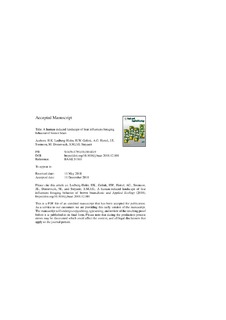A human-induced landscape of fear influences foraging behavior of brown bears
Lodberg-Holm, Hanna Kavli; Gelink, Henriette Wathne; Hertel, Anne Gabriela; Swenson, Jon; Domevscik, Matej; Steyaert, Sam
Journal article, Peer reviewed
Accepted version
Permanent lenke
http://hdl.handle.net/11250/2592388Utgivelsesdato
2018Metadata
Vis full innførselSamlinger
Sammendrag
Animals adapt their foraging behavior to variations in food availability and predation risk. In Sweden, brown bears (Ursus arctos) depend on a nearly continuous intake of berries, especially bilberries (Vaccinium myrtillus) during late summer and early autumn to fatten up prior to hibernation. This overlaps with the bear hunting season that starts on 21 August. Bilberry occurrence varies across space, as does human-induced mortality risk. Here, we hypothesize that brown bears select for areas with a high probability of bilberry occurrence across a boreal forest ecosystem in Sweden (H1), and that human-induced mortality risk reduces bear selection for bilberries (H2). In addition, we hypothesized that bears that survived the hunting season avoided bilberry areas associated with high risk, whereas bears that were later killed selected more strongly for berries and less against risk prior to the hunting season (H3). To evaluate our hypotheses, we used resource selection functions to contrast bear GPS relocation data (N = 35, 2012–2015) and random positions within the bearś home range with generalized linear mixed effect models against two focal variables: a map predicting bilberry occurrence and a map predicting human-induced mortality risk. We found that bears selected for areas with a high probability of bilberry occurrence (supporting H1), but avoided these areas if they were associated with and high risk of hunting mortality (supporting H2). The killed and surviving bears did not differ in their selection for bilberries, but they did differ in their selection against risk (partially supporting H3). Surviving bears strongly avoided high risk areas, whereas killed bears responded less to risk and selected for high-risk areas with a low probability of bilberry occurrence. This suggests that killed bears selected for other food sources than berries in high risk areas, which exposed them to human hunters. We conclude that bears respond to a landscape of fear during the berry season and that different foraging strategies may have a direct impact on individual mortality during the hunting season.
